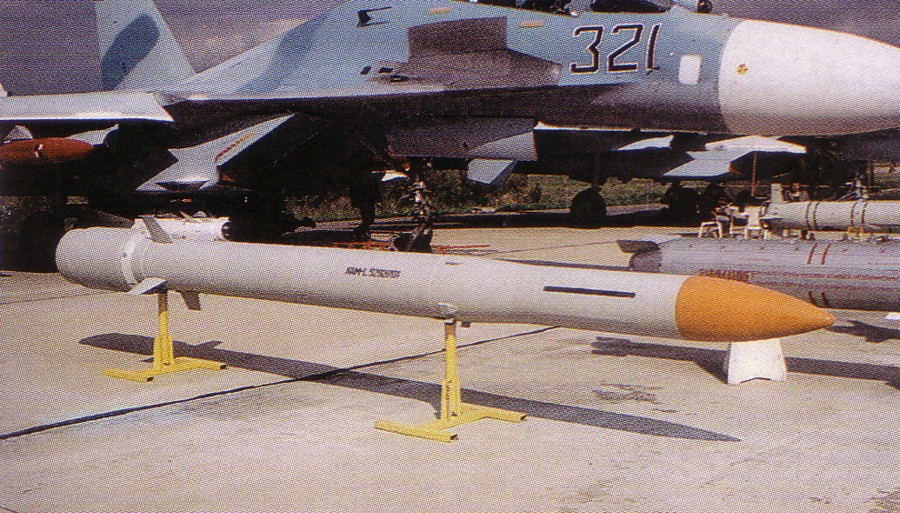LETHALFORCE
New Member
- Joined
- Feb 16, 2009
- Messages
- 29,968
- Likes
- 48,929
http://warfare.ru/?lang=&catid=262&linkid=2175&linkname=KS-172-RVV-L
KS-172 RVV-L
purpose: super long range
design bureau: Novator
development: early 1997
1st Air tests: in 1993
length: 7.4 m
diameter: 0.51
wingspan: 0.75
missile wt: 750 kg
warhead wt: 50 kg
envelope: 3 to 30000 m
Range: about 400 km
Guidance: Inertial + active radarhoming
Carried by: Mig-31M; SU-35/37/S-37
he KS-172 may have been based on the airframe of the 9K37M1 Buk-M surface-to-air missile. It used a two-stage rocket engine with a flight speed of about Mach 4 and a claimed maximum range of 400 km (250 mi). The AAM-L flies to the vicinity of the target by inertial navigation, then activates its own active radar for terminal homing.
The AAM-L missile is intended for use against Airborne Early Warning, tanker, and maritime patrol aircraft, giving an air force the ability to attack these vital assets without having to engage their fighter escorts. Enhanced-range versions have also been suggested as possible anti-satellite weapons.
India Starts Defence Exports : Joint Ventures Now yielding rich Dividends
KS -172
- Joint Venture between India's DRDO and Russias NPO Novator.
SpeciFications :
- It is an ultra Long Range AAM with a Development Range of 400KMs To Target AEW/AWAC Type High Value Aircrafts.
- Sole Carrier in the Indian AF will be the Su-30MKI
Features ( Dimensions) :
- 1.4 Meter long Rocket Booster
- Weight 748Kgs
- Core Diameter 0.40 Meter , Total Lenght 6.01 Meters , Span .61 Meters
- Launched by a Solid-propellant Tandem Rocket Booster
- The KS 172 will attack its Targets with an adaptive high explosive ( HE) fragmentation warhead.
Guidance
- Secure Data-Linked Based inertial Navigation System for MidCourse Guidance ( This would probably be done by AWACS or the 2-3 MKIs Working in Tandem with their Mini AWACS Capability)
- Active Radar Homing for its Terminal Phase.
-The missile will be used against air targets flying at altitudes from 3m to 30km with speeds up to 4,000km/h and manoeuvring at up to 12g.
INDO-RUSSO CO-OPERATION
DRDO and NPO will jointly Develop:
- An Active Homing Radar Seeker with a Wide Lock-On Range Which is able to recieve targeting data from the launch AC.
- Design a combined Gas/AeroDynamic Control system with 3d TVC . Provides High Manoeuvrability irrespective of launch Conditions and allows for missle launch with AC in super Manoeuvrability flight mode.
- Create and Adaptive Rapid Reaction Autopilot Which Optimises with Missile Stabilization and control Parameters within the firing range.
- Development of Special Interaction Logic btween the KS-172 Explosive Fuse and Guidance system Which ( In addition to structural and config features) gurantees absolute immunity of the Warhead detonation system to Jamming
KS-172 RVV-L
purpose: super long range
design bureau: Novator
development: early 1997
1st Air tests: in 1993
length: 7.4 m
diameter: 0.51
wingspan: 0.75
missile wt: 750 kg
warhead wt: 50 kg
envelope: 3 to 30000 m
Range: about 400 km
Guidance: Inertial + active radarhoming
Carried by: Mig-31M; SU-35/37/S-37
he KS-172 may have been based on the airframe of the 9K37M1 Buk-M surface-to-air missile. It used a two-stage rocket engine with a flight speed of about Mach 4 and a claimed maximum range of 400 km (250 mi). The AAM-L flies to the vicinity of the target by inertial navigation, then activates its own active radar for terminal homing.
The AAM-L missile is intended for use against Airborne Early Warning, tanker, and maritime patrol aircraft, giving an air force the ability to attack these vital assets without having to engage their fighter escorts. Enhanced-range versions have also been suggested as possible anti-satellite weapons.
India Starts Defence Exports : Joint Ventures Now yielding rich Dividends
KS -172
- Joint Venture between India's DRDO and Russias NPO Novator.
SpeciFications :
- It is an ultra Long Range AAM with a Development Range of 400KMs To Target AEW/AWAC Type High Value Aircrafts.
- Sole Carrier in the Indian AF will be the Su-30MKI
Features ( Dimensions) :
- 1.4 Meter long Rocket Booster
- Weight 748Kgs
- Core Diameter 0.40 Meter , Total Lenght 6.01 Meters , Span .61 Meters
- Launched by a Solid-propellant Tandem Rocket Booster
- The KS 172 will attack its Targets with an adaptive high explosive ( HE) fragmentation warhead.
Guidance
- Secure Data-Linked Based inertial Navigation System for MidCourse Guidance ( This would probably be done by AWACS or the 2-3 MKIs Working in Tandem with their Mini AWACS Capability)
- Active Radar Homing for its Terminal Phase.
-The missile will be used against air targets flying at altitudes from 3m to 30km with speeds up to 4,000km/h and manoeuvring at up to 12g.
INDO-RUSSO CO-OPERATION
DRDO and NPO will jointly Develop:
- An Active Homing Radar Seeker with a Wide Lock-On Range Which is able to recieve targeting data from the launch AC.
- Design a combined Gas/AeroDynamic Control system with 3d TVC . Provides High Manoeuvrability irrespective of launch Conditions and allows for missle launch with AC in super Manoeuvrability flight mode.
- Create and Adaptive Rapid Reaction Autopilot Which Optimises with Missile Stabilization and control Parameters within the firing range.
- Development of Special Interaction Logic btween the KS-172 Explosive Fuse and Guidance system Which ( In addition to structural and config features) gurantees absolute immunity of the Warhead detonation system to Jamming
Last edited:

